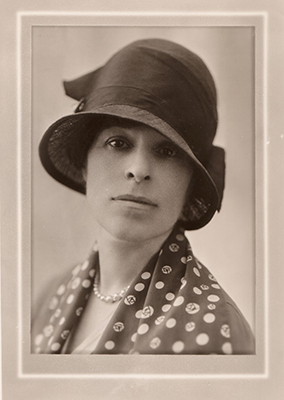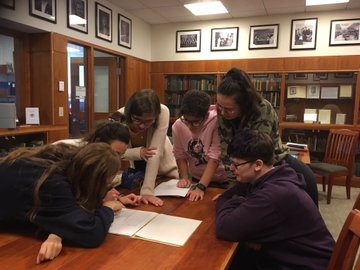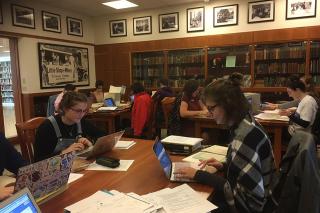In Fall 2019, a group of 11 Simmons undergraduate students began researching the lost West End. Once known as a “multi-ethnic, multi-religious immigrant enclave,” the West End was lost to the wave of urban redevelopment that swept Boston in the 1950s — the mostly working-class residents were evicted in order to clear 40 acres for new construction.
Decades later, those displaced West Enders still identify with their old neighborhood, keeping its memory alive in The West Ender newsletter and the West End Museum. This community lives on in oral histories, family photographs, and archival collections around Boston.

Simmons Archivist Jason Wood, Assistant Director for Service Learning in Simmons Community Engagement Meghan Doran, and Laura Prieto, Alumni Chair in Public Humanities at Simmons University and Professor of History and Women's and Gender Studies, aided the students in their research. They used a collection of papers donated to Simmons by Eva Whiting White, a Simmons social work graduate from 1907, and a pivotal figure in the history of the West End. They also partnered with the Boston City Archives, which keeps all the city’s official government records and documents.
“I’ve never done anything like this before,” says history major and journalism minor, Sarah Carlon ’21. “We got the freedom to be independent and do archival research and secondary research by ourselves, but we were able to coordinate with Jason and Professor Prieto. I’m excited for what we’ve put together.”
Supported by a “Humanities Research for the Public Good” grant from the Council of Independent Colleges, the students created a series of exhibits, including one for the West End Museum, one on Simmons’ campus, and a digital exhibit. While the physical exhibits are on hold due to the pandemic, the digital exhibit is open — thanks to Wood and the Archives staff, who digitized all of the items the students had selected for the exhibits before campus closed due to the COVID-19 pandemic.
The students also drew from their research to guest-write a series of blog posts about the West End, posted beginning in February on the Boston City Archives Twitter feed as a #Fridayswitheva series. These online experiences invite members of the wider community to learn of the impact the West End had on residents and the impact of its loss.
History and economics major, Jordan Ziese ’21, expected a resume booster but has seen some unexpected gains. “I’ve been forced to improve my articulation of historic things,” she says. “I was explaining the exhibit to a friend and mentioned a settlement house worker, and then I stopped and explained what a settlement house worker was, and she thanked me for explaining it to her. Professor Prieto has taught us how to better articulate ourselves, and it forces us to know these concepts better.”
The ability to talk about their research has been vital. Last December, the group presented an exhibit pitch to the West End Museum, centered around the theme “Learned from our Neighbors,” which presents everyday life and stories of those who spent time at the Elizabeth Peabody House (EPH), a community center, especially during the 1920-1930s.
“We focused on people’s stories from that time,” said Mavis Reardon ’21, a history major. “The stories create an understanding of the West End as a very multi-ethnic neighborhood with a big immigrant population, and what that meant in Boston in that time period, with assimilation. The exhibit shows the importance of those individual voices.”
Noah Cabral ’20, ’21MA, a history and political science major, had expected to focus on the urban renewal period. “But going through the materials we chose to include, everything fit within the 1920s and ‘30s, so that’s kind of where our focus went.” This kept the focus on the people as they lived in the West End, instead of focusing on the “tragic ending of it all,” Reardon noted.
History and political science major, Lilli Thorne ’20, said the project has broadened her concept of working in history. “It’s more of a group effort than anything I’ve experienced before. I’m also working on my senior thesis, and that’s a solo endeavor. So working on a history project with a bunch of other people who get exactly what I’m doing has shown me that history can be collaborative, too.”

“The students have been working with a rich, diverse collection of materials,” adds Professor Prieto. In addition to letters, concert programs, diagrams, floor plans, and reports, there are items specific to the Eva Whiting White collection. “Eva was collecting her own research — newspaper clippings, photographs, notes about pet shows and science fairs, and all of the programs that the EPH was running.” The students also transcribed pages from White’s handwritten diaries for unique insights into her daily life.
“The transcriptions were interesting,” noted public history major Chloe Feuerstein ’20. “There’s a lot about Eva’s daily life, how she structured her day, who she’s seeing and the connections that she has — outside of Boston, inside of Boston — that plays a role in our understanding of her and the settlement house and how all of this is connected together. So even if we don’t use the exact material, the background research is still useful.”
Professor Prieto notes that the collection hadn’t received much attention before this project. “White is not widely recognized, and this extensive paper collection is a valuable window into what that community was like when it was intact. There are still people who think of themselves as West Enders.”
Andrew Porter, Simmons Associate Professor of Practice in Communications, is one such West Ender, who met with the group and shared family photographs. The contact with other individuals has been invaluable to the project, broadening the perspective.
“I'm so very proud of the work the students have been doing,” Prieto adds, citing their creative ideas for presenting the materials. Feuerstein plans to collaborate with other students to create a zine, “almost like a scrapbook,” she said, “of stuff that was fun and interesting, just to get people’s interest and channel it toward the digital exhibit.”
No doubt, the project will have a lasting impact. “Working with the materials and observing everything has led me to realize I would like to go into the archives field after I graduate,” adds Kathleen McCarver ’21, a history and information technology major. “I’ve found an internship, and I’m making plans for graduate school. So yes, it led me to something that I have a very strong passion for that I didn’t realize until this project.”
Students Noah Cabral ’20, ’21MA, Sarah Carlon ’21, Lavender Martin ’20, Madeline Short ’22, and Jordan Ziese ’21 also presented a panel, “Introduction to Public Histories: Scholarship and Community-Building” moderated by Professor Prieto, at the Simmons Undergraduate Symposium on April 23. The panel discussion focused on how they used the archival papers of Eva Whiting White.

